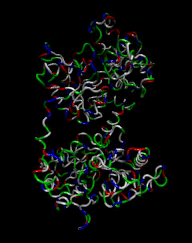
This animated .gif shows the vibrating modes of a protein called conalbumin, found in egg whites. A new technique picks up the acoustic signals given off by such vibrations, which can be used to identify proteins and tell whether they’ve been altered by mutation or interactions with drugs.
A new technique called electronic acoustic Raman (EAR) spectroscopy could improve the way we study proteins, which in turn could help fight diseases like cystic fibrosis. The technique involves using a laser to excite small molecules like proteins; when excited they vibrate and give off sound at a specific frequency.
By analysing the sound, researchers can tell which proteins are present or if any of them are altered through mutation or interactions with drugs. Unlike current techniques for studying proteins, EAR doesn’t require dyes or labels, is low cost and can even zoom in on a single molecule.
The researchers have demonstrated proof of concept using nanoparticles and 5 different proteins, all of which showed unique acoustic signals. The technique could help discover new drugs or assist in the study of diseases like cystic fibrosis, which is caused by a mutated protein.
Original research paper published by Nature Photonics on November 24, 2014.
Names and affiliations of selected authors
